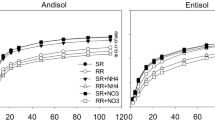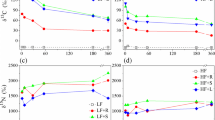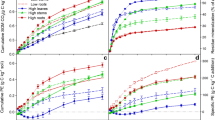Abstract
Input of plant residue carbon (C) stimulates microbial growth and activity, and thus may alter native soil organic matter (SOM) mineralization. The partition of plant residue C between microbial growth and respiration, and priming effect on soil organic C (SOC) are affected by initial SOM levels and plant residue types. However, how the interaction between SOM level and plant residue on microbial C use efficiency (CUE) and soil priming effect remains not very clear. Here, we quantified the ratio of plant residue C converted to microbial biomass production (as MBC) over that uptake by microorganism (MBC + respiration) and the priming effect on native SOC in two soils (with low and high initial SOM levels, abbreviated as LSOM and HSOM, respectively) added with 13C-labeled maize residues (root, stem and leaf) through a 180-day incubation. Microbial CUE of maize residue was the highest in the HSOM soil with leaf residue addition, and was the lowest in LSOM soil with stem and leaf residues addition. About 37% ~ 47% of maize residue C was remained in the soil after 180 days. At the end of incubation, the positive cumulative priming effects on native SOC mineralization induced by stem and leaf residues were 23% and 30% stronger (P < 0.05) in the HSOM soil than those of the LSOM soil, respectively. In contrast the root residue addition induced the negative priming effect on native SOC in the two SOM levels of soils. Overall, microbial CUE of maize residue was higher in soil with high initial SOM level, which is likely to promote SOM formation via microbial biomass, although there are many other factors that influence SOM formation. The interactive effect between initial SOM level and plant residue quality should be considered when understanding long-term SOM storage.






Similar content being viewed by others
Data availability
Enquiries about data availability should be directed to the authors.
Abbreviations
- C:
-
Carbon
- N:
-
Nitrogen
- C/N:
-
Ratio of carbon to nitrogen
- SOM:
-
Soil organic matter
- SOC:
-
Soil organic carbon
- MBC:
-
Microbial biomass carbon
- CUE:
-
Carbon use efficiency
- LSOM:
-
Low level of initial soil organic matter
- HSOM:
-
High level of initial soil organic matter
References
Abiven S, Recous S, Reyes V, Oliver R (2005) Mineralisation of C and N from root, stem and leaf residues in soil and role of their biochemical quality. Biol Fertil Soils 42:119–128
Agumas B, Blagodatsky S, Balume I, Musyoki MK, Marhan S, Rasche F (2021) Microbial carbon use efficiency during plant residue decomposition: Integrating multi-enzyme stoichiometry and C balance approach. Appl Soil Ecol 159:103820
An T, Schaeffer S, Zhuang J, Radosevich M, Li S, Li H, Pei J, Wang J (2015a) Dynamics and distribution of 13C-labeled straw carbon by microorganisms as affected by soil fertility levels in the black soil region of Northeast China. Biol Fertil Soils 51:605–613
An T, Schaeffer S, Li S, Fu S, Pei J, Li H, Zhuang J, Radosevich M, Wang J (2015b) Carbon fluxes from plants to soil and dynamics of microbial immobilization under plastic film mulching and fertilizer application using 13C pulse-labeling. Soil Biol Biochem 80:53–61
Aye NS, Butterly CR, Sale PW, Tang C (2018) Interactive effects of initial pH and nitrogen status on soil organic carbon priming by glucose and lignocellulose. Soil Biol Biochem 123:33–44
Bai Z, Li H, Yang X, Zhou B, Shi X, Wang B, Li D, Shen J, Chen Q, Qin W, Oenema O (2013) The critical soil P levels for crop yield, soil fertility and environmental safety in different soil types. Plant Soil 372:27–37
Bardgett RD, Wardle DA (2003) Herbivore-mediated linkages between aboveground and belowground communities. Ecology 84:2258–2268
Blake GR, Hartge KH (1986) Bulk density. In: Klute A (ed) Methods of soil analysis. Part 1, physical and mineralogical methods. Agronomy monograph No. 9, 2nd edn. Soil Science Society of America, Madison, pp 363–375
Blagodatskaya E, Kuzyakov Y (2008) Mechanisms of real and apparent priming effects and their dependence on soil microbial biomass and community structure: critical review. Biol Fertil Soils 45:115–131
Blagodatskaya E, Yuyukina T, Blagodatsky S, Kuzyakov Y (2011) Three-source-partitioning of microbial biomass and of CO2 efflux from soil to evaluate mechanisms of priming effects. Soil Biol Biochem 43:778–786
Butcher KR, Nasto MK, Norton JM, Stark JM (2020) Physical mechanisms for soil moisture effects on microbial carbon-use efficiency in a sandy loam soil in the western United States. Soil Biol Biochem 150:107969
Chen R, Senbayram M, Blagodatsky S, Myachina O, Dittert K, Lin X, Blagodatskaya E, Kuzyakov Y (2014) Soil C and N availability determine the priming effect: microbial N mining and stoichiometric decomposition theories. Glob Change Biol 20:2356–2367
Chen Y, Li W, You Y, Ye C, Shu X, Zhang Q, Zhang K (2022) Soil properties and substrate quality determine the priming of soil organic carbon during vegetation succession. Plant Soil 8:1–7
Cheng WX (1999) Rhizosphere feedbacks in elevated CO2. Tree Physiol 19:313–320
Clemente JS, Simpson MJ, Simpson AJ, Yanni SF, Whalen JK (2013) Comparison of soil organic matter composition after incubation with maize leaves, roots, and stems. Geoderma 192:86–96
Cotrufo MF, Wallenstein MD, Boot CM, Denef K, Paul E (2013) The microbial efficiency-matrix stabilization (MEMS) framework integrates plant litter decomposition with soil organic matter stabilization: do labile plant inputs form stable soil organic matter? Glob Chang Biol 19:988–995
Craine JM, Morrow C, Fierer N (2007) ESA online journals—microbial nitrogen limitation increases decomposition. Ecology 88:2105–2113
Domeignoz-Horta LA, Pold G, Liu X, Frey SD, Melillo JM, DeAngelis KM (2020) Microbial diversity drives carbon use efficiency in a model soil. Nat Commun 11:1–10
Duan Y, Xu M, Wang B, Yang X, Huang S, Gao S (2011) Long-term evaluation of manure application on maize yield and nitrogen use efficiency in China. Soil Sci Soc Am J 75:1562–1573
Fang Y, Singh BP, Collins D, Li B, Zhu J, Tavakkoli E (2018) Nutrient supply enhanced wheat residue-carbon mineralization, microbial growth, and microbial carbon-use efficiency when residues were supplied at high rate in contrasting soils. Soil Biol Biochem 126:168–178
Fontaine S, Hénault C, Aamor A, Bdioui N, Bloor JMG, Maire V, Mary B, Revaillot S, Maron PA (2011) Fungi mediate long term sequestration of carbon and nitrogen in soil through their priming effect. Soil Biol Biochem 43:86–96
Fontaine S, Mariotti A, Abbadie L (2003) The Priming effect of organic matter: a question of microbial competition? Soil Biol Biochem 35:837–843
Garcia-Pausas J, Paterson E (2011) Microbial community abundance and structure are determinants of soil organic matter mineralization in the presence of labile carbon. Soil Biol Biochem 43:1705–1713
Geyer KM, Kyker-Snowman E, Grandy AS, Frey SD (2016) Microbial carbon use efficiency: accounting for population, community, and ecosystem-scale controls over the fate of metabolized organic matter. Biogeochemistry 127:173–188
Geyer KM, Dijkstra P, Sinsabaugh R, Frey SD (2019) Clarifying the interpretation of carbon use efficiency in soil through methods comparison. Soil Biol Biochem 128:79–88
Johnson JMF, Barbour NW, Weyers SL (2007) Chemical composition of crop biomass impacts its decomposition. Soil Sci Soc Am J 71:155–162
Jones DL, Hill PW, Smith AR, Farrell M, Ge T, Banning NC, Murphy DV (2018) Role of substrate supply on microbial carbon use efficiency and its role in interpreting soil microbial community-level physiological profiles (CLPP). Soil Biol Biochem 123:1–6
Kaschuk G, Alberton O, Hungria M (2010) Three decades of soil microbial biomass studies in Brazilian ecosystems: lessons learned about soil quality and indications for improving sustainability. Soil Biol Biochem 42:1–3
Kumar A, Phillips RP, Scheibe A, Klink S, Pausch J (2020) Organic matter priming by invasive plants depends on dominant mycorrhizal association. Soil Biol Biochem 140:107645
Kuzyakov Y (2010) Priming effects: interactions between living and dead organic matter. Soil Biol Biochem 42:1363–1371
Kuzyakov Y, Friedel JK, Stahr K (2000) Review of mechanisms and quantification of priming effects. Soil Biol Biochem 32:1485–1498
Lal R (2004) Soil carbon sequestration to mitigate climate change. Geoderma 123:1–22
Lashermes G, Gainvors-Claisse A, Recous S, Bertrand I (2016) Enzymatic strategies and carbon use efficiency of a litter-decomposing fungus grown on maize leaves, stems, and roots. Front Microbiol 7:1315
Li J, Pei J, Dijkstra FA, Nie M, Pendall E (2021) Microbial carbon use efficiency, biomass residence time and temperature sensitivity across ecosystems and soil depths. Soil Biol Biochem 154:108117
Liang X, Yuan J, Yang E, Meng J (2017) Responses of soil organic carbon decomposition and microbial community to the addition of plant residues with different C: N ratio. Eur J Soil Biol 82:50–55
Liang C, Amelung W, Lehmann J, Kästner M (2019) Quantitative assessment of microbial necromass contribution to soil organic matter. Glob Chang Biol 25:3578–3590
Lu R (2000) Methods for soil agrochemistry analysis. China Agricultural Science and Technology Press, Beijing, pp 106–310
Ma Q, Watanabe T, Zheng J, Funakawa S (2021) Interactive effects of crop residue quality and nitrogen fertilization on soil organic carbon priming in agricultural soils. J Soils Sediments 21:83–95
Manzoni S, Porporato A (2009) Soil carbon and nitrogen mineralization: theory and models across scales. Soil Biol Biochem 41:1355–1379
Manzoni S, Taylor P, Richter A, Porporato A, Agren GI (2012) Environmental and stoichiometric controls on microbial carbon-use efficiency in soils. New Phytol 196:79–91
Mehnaz KR, Corneo PE, Keitel C, Dijkstra FA (2019) Carbon and phosphorus addition effects on microbial carbon use efficiency, soil organic matter priming, gross nitrogen mineralization and nitrous oxide emission from soil. Soil Biol Biochem 134:175–186
Meyer N, Welp G, Rodionov A, Borchard N, Martius C, Amelung W (2018) Nitrogen and phosphorus supply controls soil organic carbon mineralization in tropical topsoil and subsoil. Soil Biol Biochem 119:152–161
Mo F, Zhang YY, Liu Y, Liao YC (2021) Microbial carbon-use efficiency and straw-induced priming effect within soil aggregates are regulated by tillage history and balanced nutrient supply. Biol Fertil Soils 57:409–420
Moreno-Cornejo J, Zornoza R, Doane TA, Faz A, Horwath WR (2015) Influence of cropping system management and crop residue addition on soil carbon turnover through the microbial biomass. Biol Fertil Soils 51:839–845
Oliver EE, Houlton BZ, Lipson DA (2021) Controls on soil microbial carbon use efficiency over long-term ecosystem development. Biogeochemistry 152:309–325
Paustian K, Six J, Elliott ET, Hunt HW (2000) Management options for reducing CO2 emissions from agricultural soils. Biogeochemistry 48:147–163
Perelo LW, Munch JC (2005) Microbial immobilization and turnover of 13C labelled substrates in two arable soils under field and laboratory conditions. Soil Biol Biochem 37:2263–2272
Poeplau C, Helfrich M, Dechow R, Szoboszlay M, Tebbe CC, Don A, Greiner B, Zopf D, Thumm U, Korevaar H, Geerts R (2019) Increased microbial anabolism contributes to soil carbon sequestration by mineral fertilization in temperate grasslands. Soil Biol Biochem 130:167–176
Potthast K, Hamer U, Makeschin F (2010) Impact of litter quality on mineralization processes in managed and abandoned pasture soils in Southern Ecuador. Soil Biol Biochem 42:56–64
Sauvadet M, Lashermes G, Alavoine G, Recous S, Chauvat M, Maron PA, Bertrand I (2018) High carbon use efficiency and low priming effect promote soil C stabilization under reduced tillage. Soil Biol Biochem 123:64–73
Schimel JP, Weintraub MN (2003) The implications of exoenzyme activity on microbial carbon and nitrogen limitation in soil: a theoretical model. Soil Biol Biochem 35:549–563
Shahbaz M, Kuzyakov Y, Heitkamp F (2017a) Decrease of soil organic matter stabilization with increasing inputs: mechanisms and controls. Geoderma 304:76–82
Shahbaz M, Kuzyakov Y, Sanaullah M, Heitkamp F, Zelenev V, Kumar A, Blagodatskaya E (2017b) Microbial decomposition of soil organic matter is mediated by quality and quantity of crop residues: mechanisms and thresholds. Biol Fertil Soils 53:287–301
Smith P (2008) Land use change and soil organic carbon dynamics. Nutr Cycl Agroecosyst 81:169–178
Soares M, Rousk J (2019) Microbial growth and carbon use efficiency in soil: links to fungal-bacterial dominance, SOC-quality and stoichiometry. Soil Biol Biochem 131:195–205
Spohn M, Pötsch EM, Eichorst SA, Woebken D, Wanek W, Richter A (2016) Soil microbial carbon use efficiency and biomass turnover in a long-term fertilization experiment in a temperate grassland. Soil Biol Biochem 97:168–175
Stewart CE, Plante AF, Paustian K, Conant RT, Six J (2008a) Soil carbon saturation: linking concept and measurable carbon pools. Soil Sci Soc Am J 72:379–392
Stewart CE, Paustian K, Conant RT, Plante AF, Six J (2008b) Soil carbon saturation: evaluation and corroboration by long-term incubations. Soil Biol Biochem 40:1741–1750
Takriti M, Wild B, Schnecker J, Mooshammer M, Knoltsch A, Lashchinskiy N, Alves RJE, Gentsch N, Gittel A, Mikutta R, Wanek W (2018) Soil organic matter quality exerts a stronger control than stoichiometry on microbial substrate use efficiency along a latitudinal transect. Soil Biol Biochem 121:212–220
Vance ED, Brookes PC, Jenkinson DS (1987) An extraction method for measuring soil microbial biomass C. Soil Biol Biochem 19:703–707
Wang Q, Wang S, He T, Liu L, Wu J (2014) Response of organic carbon mineralization and microbial community to leaf litter and nutrient additions in subtropical forest soils. Soil Biol Biochem 71:13–20
Wang H, Xu W, Hu G, Dai W, Jiang P, Bai E (2015) The priming effect of soluble carbon inputs in organic and mineral soils from a temperate forest. Ocecologia 178:1239–1250
Wei H, Guenet B, Vicca S, Nunan N, Asard H, AbdElgawad H, Shen W, Janssens IA (2014) High clay content accelerates the decomposition of fresh organic matter in artificial soils. Soil Biol Biochem 77:100–108
Wu J, Joergensen G, Pommerening B, Chaussod R, Brookes PC (1990) Measurement of soil microbial biomass C by fumigation–extraction–an automated procedure. Soil Biol Biochem 22:1167–1169
Xu X, Thornton PE, Post WM (2013) A global analysis of soil microbial biomass carbon, nitrogen and phosphorus in terrestrial ecosystems. Glob Ecol Biogeogr 22:737–749
Zhang W, Liu K, Wang J, Shao X, Xu M, Li J, Wang X, Murphy DV (2015) Relative contribution of maize and external manure amendment to soil carbon sequestration in a long-term intensive maize cropping system. Sci Rep 5:10791
Zhang X, Han X, Yu W, Wang P, Cheng W (2017) Priming effects on labile and stable soil organic carbon decomposition: pulse dynamics over two years. PLoS ONE 12:e0184978
Acknowledgements
We are thankful to Jun Zeng’s comments on this manuscript. China Scholarship Council is appreciated for providing financial support to the visit of Ninghui Xie to the University of Tennessee.
Funding
Funding was provided by National Key R&D Program of China (Grant No. 2021YFD1500204), [National Natural Science Foundation of China, (Grant Nos. 41977086, 41701330) and Scientific Research Project of Liaoning, (Grant No. LSNQN202008)].
Author information
Authors and Affiliations
Corresponding authors
Ethics declarations
Conflict of interest
The authors have not disclosed any competing interests.
Additional information
Responsible Editor: Edith Bai.
Publisher's Note
Springer Nature remains neutral with regard to jurisdictional claims in published maps and institutional affiliations.
Supplementary Information
Below is the link to the electronic supplementary material.
Rights and permissions
About this article
Cite this article
Xie, N., An, T., Zhuang, J. et al. High initial soil organic matter level combined with aboveground plant residues increased microbial carbon use efficiency but accelerated soil priming effect. Biogeochemistry 160, 1–15 (2022). https://doi.org/10.1007/s10533-022-00936-6
Received:
Accepted:
Published:
Issue Date:
DOI: https://doi.org/10.1007/s10533-022-00936-6




